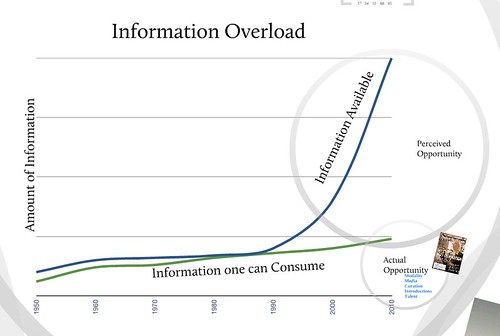Just because there’s more information available, doesn’t mean one can consume more.
Put yourself in the shoes of a consumer right now. Just for a second. Imagine that it’s the 1950s. You consume as much content as you can. You likely frequent your local library. Perhaps you listen to the radio and watch the nightly news. Maybe you also subscribe to, and read the entire, daily newspaper. Maybe your household receives a few magazines every month. That’s about it. There really isn’t a big difference between the information you know is available and the information you can consume.
Now, fast forward to the late 1990’s. You live in a 200-channel television universe, there are multiple daily metropolitan newspapers, and the worldwide web is exploding. Suddenly, there is far more content created than you can consume. Today, I’ve been told, there are an average of 17 new webpages published every second. I can’t consume every single one.
So, what do I think has happened? I can certainly consume more content than I could two decades ago, but no matter how much content is available, I can’t consume much more. And relative to the sheer volume of content available to me, I’m actually consuming a smaller percentage every day.

The Race to Curate
Now, put on your Marketer Hat or your Content Creator Hat again and take a look at the Information Overload chart above. The green line represents the consumer’s ability to consume more content. Yes, it’s gone up – but only ever-so-slightly.
Now look at the blue line (the information available). It’s sky-rocketing and shows no signs of slowing down. The consumer stands no chance of consuming much more of that wonderful content you’re creating than they could yesterday or they will tomorrow.
That means we need to define our roles in this ever-growing world of content creation. In my opinion, this is why we see a huge interest in content curation over content creation. It represents the desire of the consumer to filter out the noise and get straight to relevant, high-quality content, given the limitations on their ability to consume.
The Opportunity
So, where’s the opportunity? Content curation is certainly one avenue to pursue. Anytime you can help your audience find the best content, more efficiently, more often, you’re building trust.
However, in order to be successful at this, your brand must be perceived as a completely objective brand in the marketplace. Otherwise, your consumer has to find multiple curators and still consume more content to ensure they get the ‘whole picture.’ The content curation model is really designed to help consumers more efficiently find relevant content, not necessarily the best content.
The real opportunity here, in my opinion, is to create – and curate – the best content focused on one specific area frequently enough that you become the one brand that consumers look to for this information. It’s the opportunity of proving your brand is capable of creating and disseminating that content across media in a wide variety of formats.
If you’re just creating content for the sake of creating content, you’re not helping your consumers – you’re overwhelming them.
Note: I can’t remember where I first saw this concept. I’m not even sure if I saw the graph somewhere (I might have). If you created this concept or a similar graph, please let me know – I’d love to give you credit! Somehow, I lost it in the information overload.
